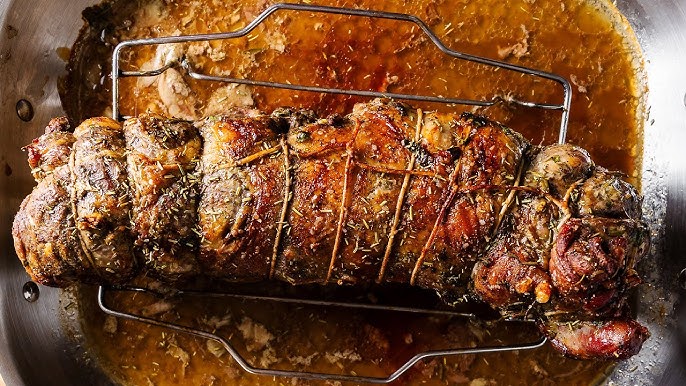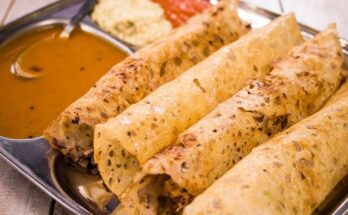Lamb Leg Recipe: There’s something undeniably celebratory about a beautifully roasted lamb leg. It’s the kind of dish that fills the house with irresistible aromas, impresses dinner guests, and turns a simple meal into a feast.
Whether you’re preparing it for a holiday, family gathering, or just because you love the taste of perfectly seasoned, slow-cooked meat, this guide will walk you through each step of making a mouthwatering lamb leg that will have everyone asking for seconds.
Why Lamb Leg is a Perfect Choice for Special Meals
A leg of lamb is not just food—it’s a centerpiece. This cut comes from the hindquarters of the lamb and is known for its tenderness, rich flavor, and impressive appearance when served whole. What makes it perfect for special occasions is not just its taste but the presentation. When roasted correctly, it develops a gorgeous crust on the outside while remaining juicy and flavorful on the inside.
Compared to other meats, lamb has a distinct, slightly gamey flavor that pairs well with herbs like rosemary, thyme, and garlic. It holds up beautifully against bold spices and sauces, making it a versatile choice for both traditional and exotic recipes.
Another reason the lamb leg stands out is its ability to feed a crowd. A single roast can easily serve six to eight people, making it ideal for gatherings. Whether you’re serving it with roasted vegetables, mashed potatoes, or a fresh salad, it brings a touch of elegance to the table that other meats simply don’t.
Nutritional Value and Flavor Profile
Lamb is not just about flavor; it’s also packed with nutrients. A well-cooked lamb leg provides high-quality protein, essential vitamins like B12, and minerals such as iron and zinc. It’s especially beneficial for those looking to boost red blood cell production and support muscle growth.
The flavor of lamb leg is deeper and more robust than beef or chicken, thanks to its fat content and muscle structure. When slow-roasted, the fat renders into the meat, enhancing every bite with juicy, aromatic richness. If seasoned right and cooked with care, lamb leg turns into a masterpiece of both taste and texture.
Choosing the Right Cut of Lamb Leg
Bone-In vs Boneless Lamb Leg
One of the first decisions you’ll make when buying a lamb leg is whether to go with bone-in or boneless. Each has its pros and cons, depending on what you’re aiming for.
- Bone-In Lamb Leg: Offers more flavor because the bone helps retain moisture and distributes heat evenly during cooking. It also makes for a more dramatic presentation. However, it takes longer to cook and can be a bit more difficult to carve.
- Boneless Lamb Leg: Easier to handle, faster to cook, and simpler to slice. Boneless cuts are often butterflied, meaning they’ve been opened up flat, which makes them perfect for marinating or grilling. But you might miss out on some of the deep flavor that the bone adds.
How to Select Quality Meat at the Butcher or Market
When you’re shopping for a lamb leg, the freshness and quality of the meat make all the difference. Here are a few tips:
- Color: Fresh lamb meat should have a deep pink to light red color with white marbling of fat. Avoid anything grayish or with yellowed fat.
- Smell: It should have a clean, neutral scent. A strong or sour smell indicates the meat is past its prime.
- Texture: The surface should be firm and moist, not slimy. If it’s vacuum-packed, check the expiration date and ensure there are no tears in the packaging.
Ask your butcher where the lamb is sourced from. Grass-fed lamb often has a cleaner, more nuanced flavor compared to grain-fed lamb. If you’re going all out, consider spring lamb—it’s younger, more tender, and usually more expensive, but perfect for that special meal.
Ingredients You’ll Need
Core Ingredients for a Classic Roast Lamb Leg
Here’s a basic ingredient list for a traditional lamb leg roast. This will yield incredible flavor with minimal fuss:
- 1 leg of lamb (4–6 pounds)
- 5–6 cloves of garlic, sliced
- 2 tablespoons fresh rosemary, chopped
- 2 tablespoons fresh thyme
- Salt and freshly ground black pepper (to taste)
- 1/4 cup olive oil
- Juice of 1 lemon
- 1 cup beef or chicken broth (optional, for roasting pan)
These ingredients form the base of a classic preparation—simple, savory, and guaranteed to bring out the lamb’s natural richness.
Optional Add-ons for Enhanced Flavor
Want to elevate your lamb leg even further? Consider adding these to your shopping list:
- Dijon mustard (rub it on for a tangy crust)
- Red wine (splash into the roasting pan for depth)
- Anchovy fillets (minced and mixed into the marinade for umami kick)
- Paprika or cumin (for a smoky or exotic twist)
- Mint jelly or sauce (a traditional pairing that balances the richness)
Preparing the Lamb Leg
Cleaning and Trimming the Meat
Before you start seasoning, it’s important to prep your meat properly. Start by patting the lamb dry with paper towels. This helps the seasoning stick better and ensures the exterior crisps up nicely in the oven.
If the lamb has a thick layer of fat, trim it down to about 1/4 inch. You don’t want to remove all the fat—some of it will melt into the meat as it cooks and add flavor. Also, look out for any silver skin (a tough, silvery membrane) and remove that with a sharp knife.
Then, score the fat in a crisscross pattern. This allows the seasoning to penetrate deeper and helps the fat render evenly during roasting.
Marination Process – Secrets for Juicy Flavor
The key to unforgettable lamb lies in the marinade. Take your garlic, rosemary, thyme, lemon juice, olive oil, salt, and pepper, and mix them into a paste. Rub this generously all over the lamb, making sure to get into every nook and cranny.
If you’re using garlic slices, make small incisions in the meat and stuff them inside. This infuses flavor deep into the lamb as it cooks.
Marinate the lamb for at least 4 hours—overnight is even better. Wrap it tightly in plastic wrap and refrigerate it. Before roasting, let the meat come to room temperature for about 1 hour to ensure even cooking.
Step-by-Step Cooking Instructions
Prepping the Oven and Roasting Pan
Now that your lamb leg is beautifully marinated, it’s time to get cooking. Preheat your oven to 375°F (190°C). This temperature is ideal for roasting the lamb slowly while still achieving that crisp, caramelized outer layer.
While the oven heats up, prepare your roasting pan. Use a sturdy, oven-safe pan or roasting dish with a rack. Placing the lamb on a rack allows the hot air to circulate all around the meat, ensuring even cooking. If you don’t have a rack, you can improvise by laying thick-cut onion slices, carrots, and celery stalks on the bottom of the pan. This not only elevates the meat but also adds aromatic flavor to the drippings, which you can turn into a delicious gravy later.
Pour about a cup of beef or chicken broth (or water if you prefer) into the bottom of the pan. This keeps the meat moist during cooking and prevents the drippings from burning. You can also toss in some whole garlic cloves and extra herbs around the lamb for added fragrance.
Once everything is ready, place the lamb leg on the rack, fat side up. This allows the fat to melt and baste the meat naturally as it roasts.
Roasting Time and Temperature Guide
Cooking time for a lamb leg largely depends on the weight of the meat and how well-done you like it. Here’s a basic guideline:
| Doneness Level | Internal Temp | Cooking Time (per lb) |
|---|---|---|
| Rare | 125°F (52°C) | 15-20 minutes |
| Medium Rare | 130°F (54°C) | 20-25 minutes |
| Medium | 140°F (60°C) | 25-30 minutes |
| Well Done | 150°F (65°C) | 30-35 minutes |
Let’s say your lamb leg is 5 pounds and you want it medium-rare. Multiply 5 pounds by 22 minutes = roughly 110 minutes (about 1 hour and 50 minutes).
Use a meat thermometer to monitor the internal temperature, inserting it into the thickest part of the meat without touching the bone. This ensures accuracy and prevents overcooking.
Halfway through the roasting time, baste the lamb with the pan juices. If the top is browning too quickly, loosely cover it with aluminum foil to prevent burning.
Once the desired temperature is reached, remove the lamb from the oven and let it rest for at least 15–20 minutes. This step is crucial. Resting allows the juices to redistribute throughout the meat, keeping it moist and tender when sliced.
Making the Perfect Gravy (Bonus Tip)
Don’t throw away those savory drippings at the bottom of the pan! Here’s a quick guide to turning them into a rich, flavorful gravy.
- Strain the Pan Juices: Pour the drippings into a saucepan through a fine mesh sieve to remove solids.
- Deglaze the Roasting Pan: Add a splash of wine or broth to the pan and scrape up all the browned bits, then add this to your saucepan.
- Thicken: In a separate bowl, mix 1 tablespoon of flour with 2 tablespoons of water or fat from the drippings to form a slurry. Stir into the pan and bring to a boil.
- Season: Taste and add salt, pepper, or a splash of lemon juice to brighten it up.
Serve this gravy warm with slices of your beautifully roasted lamb leg—it’ll take your dish to the next level.
Serving Suggestions for Lamb Leg
Side Dishes That Complement Lamb Perfectly
The rich and savory taste of lamb leg deserves equally impressive side dishes. Here are some tried-and-true pairings:
- Roasted Potatoes: Crispy on the outside, fluffy inside—classic and always welcome.
- Garlic Green Beans: A crunchy, bright contrast to the richness of the lamb.
- Buttered Carrots and Parsnips: Their natural sweetness balances the savory meat.
- Minted Peas: Fresh and light, with that signature minty zing that pairs beautifully with lamb.
- Herbed Couscous or Rice Pilaf: A fluffy grain dish can soak up all those luscious juices.
Add a fresh salad with a tangy vinaigrette to cut through the richness, and you’ve got a complete, balanced meal.
How to Carve a Lamb Leg
Carving a lamb leg may seem daunting, but it’s actually pretty straightforward. Here’s how to do it like a pro:
- Let It Rest: Before carving, make sure the lamb has rested for 15–20 minutes.
- Stabilize: Place the leg on a large cutting board with a groove to catch juices. Hold it steady with a carving fork.
- Locate the Bone: Use a sharp carving knife to slice parallel to the bone, working from the thickest part of the leg.
- Slice Thinly: Cut across the grain for tender slices. If you have a bone-in leg, work your way around the bone, flipping the meat as needed.
Serve the slices fanned out on a warm platter with fresh herbs and lemon wedges for garnish.
Storing and Reheating Leftovers
Keeping Lamb Tasty the Next Day
If you’re lucky enough to have leftovers, lamb leg stores beautifully. Here’s how to handle it:
- Refrigerate: Wrap slices tightly in foil or place in an airtight container. Use within 3–4 days.
- Freeze: For longer storage, wrap tightly in plastic wrap and foil, or vacuum seal. Label with the date and use within 2 months.
- Reheat Gently: Avoid drying it out by reheating in a covered dish with a splash of broth at 300°F (150°C) for 10–15 minutes.
Lamb also makes a fantastic filling for sandwiches, wraps, or salads the next day.
Creative Leftover Lamb Recipes
Transforming Leftovers into New Meals
Don’t let those delicious lamb slices go to waste. With just a little creativity, you can turn leftover roast lamb into entirely new dishes that are just as mouthwatering. Here are a few of our favorite ideas:
- Lamb Gyros: Thinly sliced lamb, warmed and tucked into a pita with tzatziki, tomatoes, onions, and lettuce. It’s a Mediterranean classic that’s quick and satisfying.
- Lamb Tacos: Spice up your leftovers with cumin and paprika, then serve in warm tortillas with avocado, lime, and salsa.
- Shepherd’s Pie: Chop the lamb and mix with peas, carrots, and gravy, then top with mashed potatoes and bake until golden.
- Lamb Fried Rice: Toss chopped lamb into leftover rice with garlic, soy sauce, veggies, and a scrambled egg.
- Lamb Curry: Simmer chopped lamb in a fragrant sauce of curry powder, coconut milk, ginger, and garlic for a comforting dish that pairs perfectly with rice or naan.
Each of these dishes gives your lamb a second life—and may even outshine the original meal.
Tips for Cooking Lamb Perfectly Every Time
Secrets from the Pros
Even the best recipes can fall flat without proper technique. Here are some expert tips to ensure your lamb leg turns out amazing every time:
- Let It Rest Before and After: Always allow your meat to come to room temperature before roasting and rest after cooking. This guarantees even cooking and juicier results.
- Don’t Skimp on Seasoning: Lamb can handle bold flavors. Be generous with salt, herbs, garlic, and lemon—these bring out its best qualities.
- Use a Thermometer: This is your most reliable tool for cooking meat to the perfect doneness. Guesswork is a gamble.
- Sear for More Flavor: For boneless cuts, searing in a hot pan before roasting helps lock in flavor and gives you a golden crust.
- Baste During Cooking: Spoon the pan juices over the meat every 30–40 minutes. It helps maintain moisture and adds a beautiful shine.
Master these tips, and you’ll never fear roasting lamb again.
Pairing Wines with Lamb Leg
The Best Wines to Enhance Flavor
Pairing wine with lamb is about complementing its richness. Because lamb has a bold flavor, it holds up well against robust reds. Here are some perfect pairings:
- Cabernet Sauvignon: A classic choice. Its full-bodied profile with dark fruit and tannins complements lamb’s savory notes.
- Syrah/Shiraz: Offers spicy, smoky tones that work beautifully with herb-marinated lamb.
- Zinfandel: Fruity and peppery, it cuts through the richness without overpowering it.
- Malbec: Especially with grilled or spiced lamb, this wine brings out earthy flavors.
- Pinot Noir: For those who prefer lighter wines, Pinot’s acidity and subtle cherry flavors match well with medium-rare lamb.
White wine fans? Try a Chardonnay with a creamy sauce or a Sauvignon Blanc if your lamb is served with a minty or lemony herb crust.
FAQs about Lamb Leg Recipe
1. What is the best cut of lamb for roasting?
The leg of lamb is one of the best cuts for roasting—it’s lean, tender, and packed with flavor. Bone-in or boneless both work great, depending on your preference.
2. How long should I cook a leg of lamb?
Cooking time depends on the weight and desired doneness. As a rule of thumb, roast at 350°F (175°C) for 20 minutes per pound for medium-rare, or longer for well done.
3. Should I marinate lamb leg before cooking?
Absolutely! Marinating enhances the flavor and tenderizes the meat. Let it soak in olive oil, garlic, rosemary, lemon juice, and herbs for at least 2–4 hours or overnight for best results.
4. Can I cook lamb leg in advance?
Yes, you can roast it ahead of time and gently reheat before serving. Just make sure not to overcook it during reheating to retain moisture and flavor.
5. How do I know when my lamb leg is done?
Use a meat thermometer! For medium-rare, aim for 135°F (57°C) internal temp. Let it rest for 15 minutes before slicing to allow the juices to redistribute.
6. What sides go well with roast lamb leg?
Classic sides include roasted potatoes, garlic green beans, mint sauce, couscous, or a fresh salad. Lamb pairs well with both savory and slightly sweet flavors.
7. Can I use frozen lamb leg?
Yes, but make sure to fully thaw it in the fridge for 24–48 hours before cooking. Never roast from frozen—uneven cooking can ruin your roast.
Conclusion
Cooking a lamb leg may seem like a culinary challenge, but with the right steps and some patience, it becomes a rewarding and impressive dish for any occasion. From choosing the right cut to seasoning, roasting, and carving, each step plays a role in delivering that tender, flavorful bite. And the best part? With all the leftovers, your feast can keep on giving—whether you’re making gyros, curry, or tacos the next day.
So the next time you want to wow your guests or just treat yourself to something extraordinary, roast a lamb leg. It’s not just a meal—it’s a memory on a plate.



